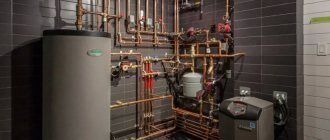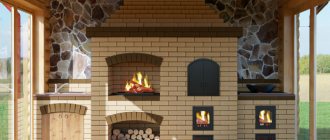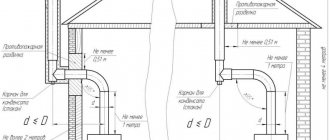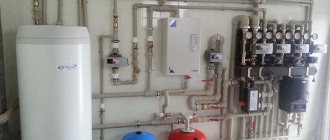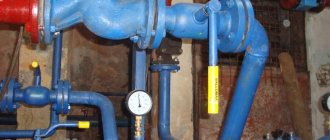Heating systems for country cottages with a height of 2 or more floors are usually designed by heating engineers. But owners of houses with a simple layout with an area of up to 200 m² do not have to turn to specialists - they can think through and organize the heating of the building themselves. The purpose of this publication is to explain which heating scheme for a two-story house is best combined with specific operating conditions, boiler equipment and radiators. We invite you to consider the existing options and choose the best one.
Boiler power calculation
The efficiency of heat generating equipment should be calculated based on the total heat loss of the building.
The following should be taken into account:
- The area of all rooms and storage rooms that require heating;
- Local features of seasonal, monthly, weekly weather;
- The general condition of the thermal insulation of the house, including its window frames;
- Density and width of external walls, interfloor ceilings, flooring;
- Construction of roof structures, the presence of an attic, attic, emergency exits to the roof;
- Size of all window, entrance, balcony doors.
Dual-circuit battery wiring
A two-pipe heating system differs from a single-pipe heating system by dividing it into two pipes - supply and return of coolant. It ensures uniform heating of all rooms. This type of wiring is used in most new houses.
Principle of operation
In a two-pipe scheme, water from the boiler flows to the radiators through the supply pipe (main).
Near each radiator, the supply line has a connecting inlet pipe through which the coolant enters the battery. The supply line ends near the last radiator.
In addition to the inlet pipe, each radiator has an outlet pipe. He connects it to the return pipe. The return line starts from the first battery and ends at the entrance to the boiler.
Thus, heated water enters the radiators evenly and at the same temperature. From each radiator, water is discharged into the return pipe, where it is collected and supplied to the boiler for subsequent heating. Thanks to this movement of the coolant, all rooms in the room are heated equally.
What is the difference
A two-pipe heating system includes elements of a single-pipe system and additional devices. In addition to the boiler, radiators, supply and return water collection pipes (the so-called return), the two-pipe circuit also includes a circulation pump.
The large length of the lines, the presence of corners and turns in the supply pipes complicate the movement of the coolant. Therefore, its forced circulation by an electric pump is necessary.
Photo 1. Circulation pump model 32-40, voltage 220 Volts, China.
Also, in a two-pipe scheme there are more taps that regulate the water supply and its quantity. Such a tap is installed in front of each radiator - at the inlet and outlet.
Classification by location
In a horizontal two-pipe system, pipes connect the radiators horizontally. This scheme works for heating a one-story house or one floor of a multi-story cottage.
In a vertical two-pipe system, pipes connect radiators located one above the other in one “riser”. However, there are differences from the single-pipe vertical scheme. Here, thanks to the presence of a supply and return pipe, vertical heating can use batteries of any width - multi-section ones (since the supply and return risers can be removed from each other). Therefore, the efficiency of two-pipe vertical heating is higher.
Reference! It is desirable that batteries of rooms located one above the other have the same number of sections. This makes it easier to lay a vertical return pipe.
Bottom and top harness: which is more effective?
The term “lower” and “upper” piping refers to the method of connecting batteries to the heating system. With the lower piping, the incoming water enters the battery through the lower pipe.
If it also comes out of the radiator at the bottom, then the efficiency of the radiator will be reduced by 20-22%.
If the outlet pipe is located at the top, the efficiency of the radiator will be reduced by 10-15%. In any case, with lower water supply to the batteries, the heating efficiency decreases.
With the top piping (supply), the incoming pipe is connected to the radiator in the upper part. In this case, the movement of the coolant is organized more efficiently, the battery will work at 97-100% (97% - if the inlet and outlet pipes are located on one side of the radiator, and 100% - if the inlet pipe is on one side from above, and the outlet pipe is on the other side from below ).
Advantages and disadvantages
Advantages:
- Suitable for organizing heating of large private houses, in which case a circulation pump must be installed into the system.
- Heats all rooms on the floor or in the riser evenly.
Flaws:
- It is more expensive than a single-pipe system, since it requires twice as many materials - pipes between the boiler and radiators, as well as connecting devices, taps, and valves.
- The electric circulation pump makes the operation of the system dependent on the availability of electricity.
Important! An increase in the number of pipes and the amount of coolant in the system leads to an increase in hydrodynamic resistance and does not allow water to move by gravity. Forced circulation and a running circulation pump are required
Water as a heat carrier
The water principle of air heating has become quite widespread, used today both in dachas and cottages, and in multi-apartment residential buildings. This heating of a two-story private house uses water mixed with certain compounds as a coolant.
The water supply infrastructure supplies it from the heating installation to the radiators. After they give off heat to the surrounding air, the cooled coolant is returned to the boiler room for reheating.
Types of heating systems
Currently, there are five heating schemes applicable for installation in a private two-story building.
These varieties include:
- Natural coolant circulation;
- Single-pipe engineering;
- Two-pipe analogue;
- Beam option;
- Full heating.
Combination of engineering solutions
These approaches to organizing heating can be combined and complementary if necessary. As a result, a high-performance and inexpensive heating system for a two-story house will be assembled.
In order to accurately assess the strengths and weaknesses of each of the listed varieties, you should study them in detail.
Primary requirements
If the system is designed taking into account SNiP, there will be no problems with it. But this is not enough. A well-thought-out configuration has the following qualities:
- Energy efficiency (cost-effectiveness). This characteristic is especially important in climatic zones with low average annual temperatures and long heating periods. Maintaining a comfortable microclimate in the house is one of the main expenses of homeowners.
- Reliability and fault tolerance. Stopping the system in the middle of the heating season is dangerous for the health of residents. And regular temperature changes and prolonged freezing cause irreparable damage to the building.
- Maximum security. All possible negative scenarios should be foreseen and the risk of their occurrence should be minimized.
- Autonomous and easy to use. A well-thought-out heating system should operate without human intervention for as long as possible.
- Full controllability. In a well-implemented system, everything can be customized. Even the microclimate in each individual room.
- Aesthetics and noiselessness. The presence of heating engineering networks in the house should only indicate the temperature in the premises. And the operation of the electric pump can be clearly heard even during the day. And if this is not corrected, residents will stop sleeping at night.
Engineering range of heating solutions
To get as complete an idea as possible about the water heating installation schemes used in two-story residential buildings, it is necessary to briefly outline their basic technical characteristics.
The basis for classification is the method of supplying coolant to the halls, kitchen, hallway and built-in bathroom.
Based on the financial capabilities of the installer and a number of architectural parameters of the building, it is possible to install:
- Single pipe configuration. This method involves connecting both battery connections to a common line, which serves as both the supply and return infrastructure.
- Two-pipe infrastructure. Two-pipe heating of a two-story house provides that the heating structures are supplied with warm water from one line, and the cooled medium is reheated through another pipe.
- Collector. In this case, the carrier is supplied to each battery through a separate line formed by a pair of pipeline structures - supply and return. As for the lines laid in the floor, they come down to a distribution manifold, which became the reason for the appearance of an alternative name for this heating structure - radiant.
Efficiency of forced circulation schemes
The prevailing part of modern heating systems can function fully only when artificial circulation is created, that is, one in which the coolant moves within the network due to the operation of the circulation pump.
Diagram of a heating system with a gas boiler in a 2-story house: equipment and metering devices are installed on the first floor (in the basement, in the basement), in a specially equipped room with good sound insulation (+)
There are prerequisites for installing forced circulation in a building with several floors:
- installation of a pipeline with a smaller diameter, which facilitates the assembly of the wiring as a whole;
- providing zonal regulation (along with or instead of general regulation);
- the presence of 2nd and higher floors does not affect the heating efficiency;
- reducing the coolant temperature without changing heat transfer parameters;
- possibility of using inexpensive plastic pipes.
The disadvantages include the availability of power supply - interruptions are possible, but they can be easily avoided by using backup UPSs. The problem of louder noise can also be solved by installing a layer of sound insulation in the boiler room.
Scheme of water heating with forced circulation: 1 – gas or electric boiler; 2 – riser; 3 – pipe to the expansion tank; 4 – riser for draining; 5 – upper horizontal wiring; 6 – expansion tank; 7 – circulation pump; 8 – return line
The most suitable place for inserting the circulation pump is where the temperature drops to a minimum, that is, directly in front of the boiler, on the return line.
Method of organizing carrier movement
The operating principle of heating systems installed in the floor is no different from manifold systems. However, the heating elements in this case are pipeline circuits, rigidly fixed in a screed or hidden in the interfloor ceiling. In the construction market, the name “warm floors” has been assigned to such systems.
According to the method of organizing water movement, heating systems are divided into two types:
- Gravitational.
- Forced.
When using the gravitational principle, the heated medium, which weighs less than cold water, rushes upward along the contour due to gravity. As a result, a rather slow but sufficient circulation occurs.
As for collectors and heated floors, in such structures gravity is not able to start circulation due to insufficiently sharp angles of inclination of the pipes and limited diameters.
Additional equipment - advantages and disadvantages
Any heating circuit can be improved by adding thermostats to adjust the operation of each battery, thermostats, a hydraulic needle, a circulation pump for each circuit, and other additional devices.
Mayevsky taps and air vents at the top of each riser are required in systems with a closed expansion tank. Each additional device makes the system more efficient, more economical, and allows for more precise and convenient settings.
It is worth remembering that excessive complexity of the system not only increases its cost, but also significantly increases the risk of breakdown
Use only the necessary components, because the fewer units, the lower the likelihood of one of them failing and stopping the system.
Single-pipe heating option
The most affordable for implementation in a two-story building is a single-pipe system. This option should be chosen by anyone who is wondering how to install heating in a two-story house quickly and inexpensively.
The main characteristics and features of this modification are:
- Low resource consumption;
- Heating the media with gas or electricity;
- Possibility of installing a brick stove;
- Accordingly, the applicability of peat, firewood and other organic matter as fuel.
Installation recommendations
In addition to the general rules for installing heating equipment and heating networks, when assembling single-pipe systems with your own hands, you need to take into account its features. Here are some recommendations on the topic:
- first make a correct calculation of pipe diameters, especially for a gravity flow scheme;
- think carefully about the laying of branches or risers so that the former do not cross doorways, and the latter do not fall on the windows;
- Connect radiators for artificial circulation using a DN15 pipe, and for natural circulation – DN20;
- Observe slopes. For a gravity system - at least 5 mm per 1 m, pressure - 3 mm;
- the height of the accelerating manifold should be 2.2 m;
- the expansion tank in an unheated attic must be insulated, and the overflow pipe must be taken outside;
- if the boiler heat exchanger is made of cast iron, do not add cold water directly to the return line near the heat generator;
Do not load one ring of the heating circuit with a large number of batteries, otherwise the last ones will be cold.
How not to overpay for heating
The “one pipe” scheme allows you to achieve a tangible economic effect. Do-it-yourself heating in a two-story house of this configuration requires a much shorter infrastructure length than a two-pipe analogue.
Other strengths of this engineering approach are:
- Low installation complexity and low cost;
- Elementary repair procedures;
- Preservation of the stylistic harmony of the interior due to the slight introduction of engineering into its composition;
- Availability of technical taps for powering the heated floor infrastructure.
Is it worth installing it yourself?
As can already be understood from all of the above, the Tichelman Loop heating has a fairly simple design. In any case, it will not be more difficult to assemble than a regular dead-end system. However, it is worth considering that the Tichelman loop is most often installed in very large houses. The assembly of heating systems in such buildings in itself has a lot of nuances. In addition, the calculation of communications for such an object should be made as accurate as possible. In this case, simply taking average values (10 kW boiler per 1 m2 of room, pipe diameters 26 and 16) will not work. It will be quite difficult to make correct calculations using tables and even using appropriate programs on your own. Therefore, it is still worth hiring specialists to design and install the Tichelman Loop system in a large house.
Our ancestors slept differently than we do. What are we doing wrong? It’s hard to believe, but scientists and many historians are inclined to believe that modern man sleeps completely differently than his ancient ancestors. Initially.
These 10 little things a man always notices in a woman Do you think your man doesn’t understand anything about female psychology? This is wrong. Not a single little thing can be hidden from the gaze of a partner who loves you. And here are 10 things.
7 Body Parts You Shouldn't Touch with Your Hands Think of your body as a temple: you can use it, but there are some sacred places that you shouldn't touch with your hands. Research showing.
20 photos of cats taken at the right moment Cats are amazing creatures, and perhaps everyone knows this. They are also incredibly photogenic and always know how to be in the right place at the right time.
15 Cancer Symptoms Women Most Often Ignore Many signs of cancer are similar to symptoms of other diseases or conditions, which is why they are often ignored.
Pay attention to your body. If you notice
How to look younger: the best haircuts for those over 30, 40, 50, 60 Girls in their 20s don’t worry about the shape and length of their hair. It seems that youth is created for experiments with appearance and daring curls. However, already last.
The need to connect a circulation pump
The single-pipe engineering circuit can be installed under the flooring without much difficulty. The only point that should not be overlooked by fans of inexpensive solutions is the fact that simply orienting the pipe horizontally or vertically will not be enough.
The fact is that the gravity configuration will work in a one-story building, but in a two-story building it will be useless. To put it into operation, you will have to acquire a special pump and provide for its installation at the design stage.
To prevent the pump from creating any inconvenience, it can be covered with noise insulation and installed away from the bedrooms and kitchen.
Balancing
The point of this operation is to balance all branches of the system and regulate the water flow in each of them. To do this, each branch must be correctly connected to the mains, that is, special balancing valves must be installed on the tie-in. Also, control taps or thermostatic valves are installed on the connections to all radiators.
It is not so easy to carry out accurate balancing with your own hands; you need to have the appropriate instruments (at least a pressure gauge to measure the pressure drop across the balance valve) and perform calculations for pressure losses. If there is none of this, then after testing you need to fill the system, bleed the air and turn on the boiler. Next, balancing of the two-pipe system is done by touch, according to the degree of heating of all batteries. Devices located next to the heat generator must be “pressed” so that more heat goes to those further away. The same goes for entire branches of the system.

